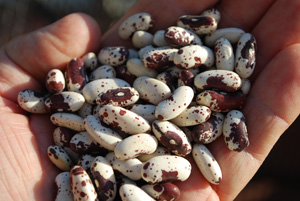Growing Beans for
Shelling and Drying
If you’re growing beans (Phaseolus vulgaris) for shelling or drying, follow the same planting and culture recommendations as you would for growing green beans, but bear in mind that plants grown to full maturity stand longer in the field.

|
|
Click IMAGE to Enlarge |
They have higher nutritional needs because they’re ripening seeds, and they have lengthened exposure to pathogens. At the same time, they’re more vulnerable, because their energy is devoted to seed production, instead of defending leaves. And with the days getting shorter and the nights colder, the odds are stacked against the plants.
With this in mind, if you’re growing beans for shelling or drying, widen plant spacing by an inch or two (2-5cm).
How to Grow Beans
|
Shelling and Drying Beans
Harvesting Beans
Instead of planting (or thinning) beans in a row to 4” (10cm) apart, plant or thin them to 6” (15cm) apart.
Instead of planting beans on 8” (20cm) centers in a deep-dug or raised garden bed, plant them on 9” (23cm) centers.
This extra room improves air circulation around plants, allowing the leaves to dry more quickly after a rain. Many plant diseases spread on wet foliage, especially late in the season. Click Here for more recommendations on preventing bean diseases.
The extra room can also improve bean size and storage qualities. The slight increase in space between plants gives each a bean plant a wider root zone, so it can tap more of the nutrients it needs to form seeds.
Yes, you’ll have fewer plants, and probably, fewer pods. But you’ll have bigger pods and bigger and better beans, and that’s the point of growing beans.
Types and Varieties of Beans
Green beans aren’t just immature beans. When growing beans, any variety can be harvested young and tender, and it will be a delicious green bean, but many green bean varieties are selected or bred for thick, meaty pods, no strings, and slow seed formation, to maximize the quantity and quality of the pods.
Shelling and Drying Beans on the other hand, are selected to maximize the quality of the seeds.
Shelling and Drying Beans
Like green beans, shelling beans can be either bush or pole types, flat or round, and multiple colors.
Bush beans grow to about 2 feet (60cm) tall, and need no staking or trellising. Pole beans are taller—6-10 feet (2-3m)—and more prolific, but have to have something to climb on. Most shelling and drying beans are from bush type plants.
OP=Open Pollinated BMV=Resists Bean Mosaic Virus A=Resists Anthracnose
'Italian Rose' (Italian heirloom) is a beautiful shelling bean with rose-steaked pods and beans, similar to cranberry beans. Bush plants grow 24-28” (60-70cm) tall.
‘Etna’ (OP, 68 days, BMV) is a cranberry-type shelling bean, pale tan, with red patches. These hardy beans are exceptionally good in soups and stews. Bush variety, plants grow to 24” (60cm).
‘Flagrano’ (French flageolet) (76 days, A, BMV, HB) is exceptionally easy to shell. Pale green beans fall out of the pods with a quick stroke of a finger. Good fresh, frozen, or dried.
‘Shelling Cannelino’ (Italian heirloom, 85 days) is an Italian staple, the white kidney bean used in minestrone and other dishes. Sturdy bush plants grow 24-28” (60-70cm) tall.
‘Tongue of Fire’ (70 days) Large, round, cranberry-type bean that’s excellent fresh, frozen, or dried. Young, red-streaked pods make great snap beans.
‘Yin-Yang’ (OP, 70 days) two-toned, half-black, half-white bean, with a black dot in the white; like a 3-dimensional yin-yang symbol. Allow beans to dry in pods for maximum color development. Bush variety, grows to 24” (60cm).
Southwestern Heirloom Beans
Growing beans is the best way to sample such Native American heirloom beans as Anasazi, Bollito and Black Runner. When cooked, these large-seeded beans are 1-1 ½” (2-4cm) long, and a great addition to fall soups or stews.
‘Anasazi’ beans, also known as New Mexico Cave beans, are cream-colored beans mottled with red blotches.
‘Bollito’ (Bollita) are tan to rose-colored beans reputed to be easier to digest than pinto beans.
‘Black Runner’ are large (1"–2.5cm) black beans from prolific, fast-growing vines.
Top of Page
|
Shelling and Drying Beans
|
Harvesting Beans
How to Grow Beans
Harvesting Beans
Harvest Shelling Beans after the beans have swelled in the pods, but while the pods are still succulent. The seeds should still be soft and green.
Shelling beans can be steamed, or sautéed lightly with vegetables. If you have large amounts, blanch them in boiling water for 2 minutes, then wisk them out and drop them into ice water to stop the cooking process. Place them in a bag and suck most of the air out, then freeze them.
Frozen shelling beans stored this way will last 2-3 months in the freezer.
For Dried Beans, leave the pods on the plants for 3-4 weeks longer, if possible. Harvest after 80-90% of the leaves have yellowed and dropped off. If a lot of late-season rain is in the forecast, pull the plants and finish drying them under cover. Many bean diseases spread on wet pods.
Top of Growing Beans
Shelling and Drying Beans
|
Harvesting Beans
How to Grow Beans
Copyright © 2009-2020, by Steve Masley, Grow-it-Organically.com
All rights reserved
HOME | About Us | Contact Us | Privacy
New! Comments
Have a question or comment about what you just read? Leave me a comment in the box below.